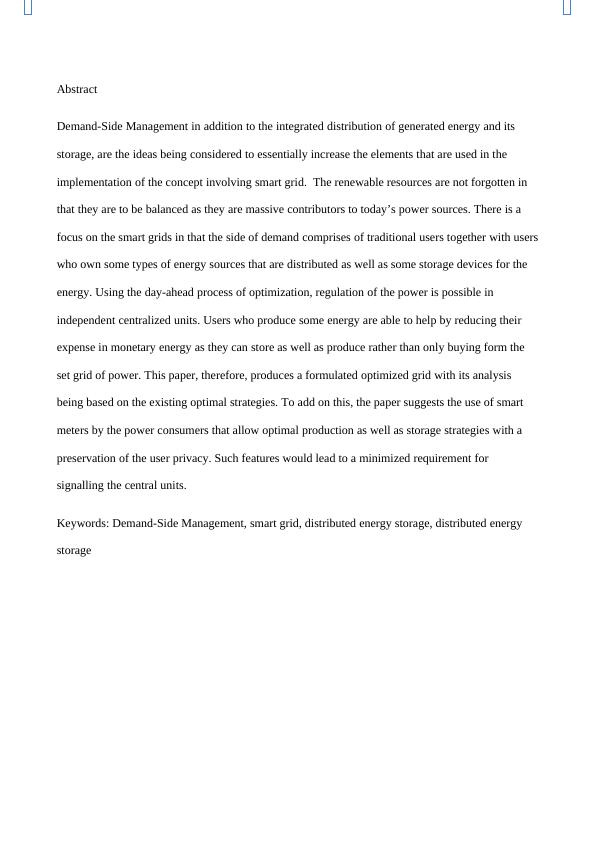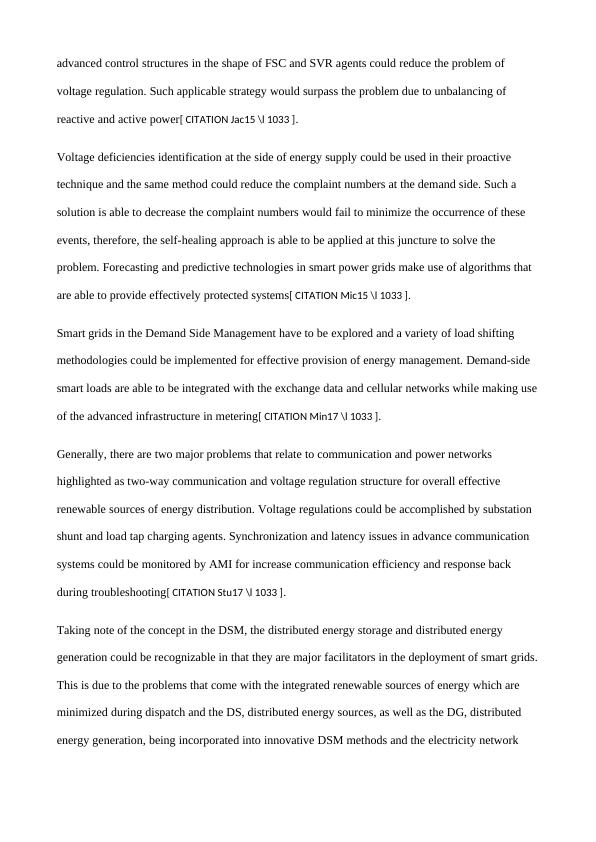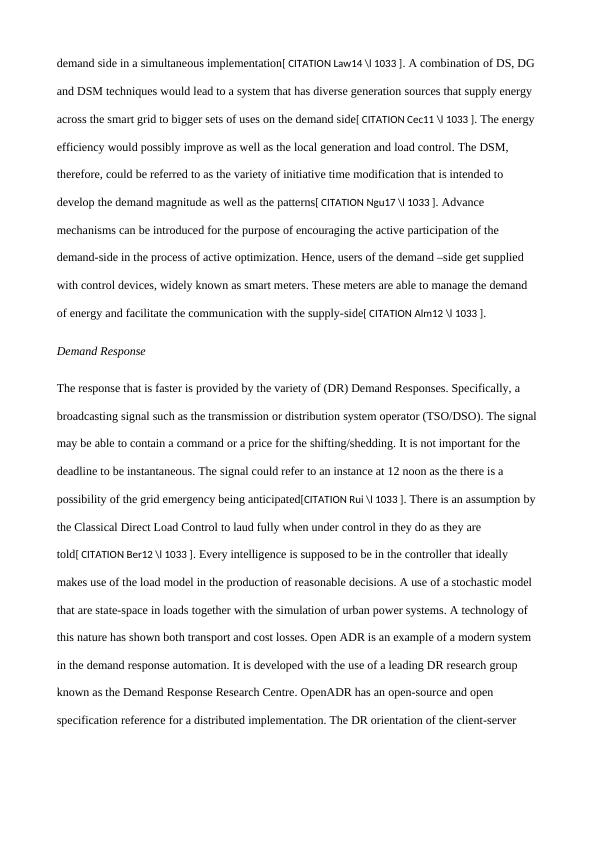Demand-Side Management in Smart Grids Assignment
Added on 2021-06-18
25 Pages12965 Words73 Views
Optimization for Supply-side and Demand-side Management in Smart GridsAssignment 1University of Wollongong, AustraliaPAT

AbstractDemand-Side Management in addition to the integrated distribution of generated energy and its storage, are the ideas being considered to essentially increase the elements that are used in the implementation of the concept involving smart grid. The renewable resources are not forgotten in that they are to be balanced as they are massive contributors to today’s power sources. There is a focus on the smart grids in that the side of demand comprises of traditional users together with userswho own some types of energy sources that are distributed as well as some storage devices for the energy. Using the day-ahead process of optimization, regulation of the power is possible in independent centralized units. Users who produce some energy are able to help by reducing their expense in monetary energy as they can store as well as produce rather than only buying form the set grid of power. This paper, therefore, produces a formulated optimized grid with its analysis being based on the existing optimal strategies. To add on this, the paper suggests the use of smart meters by the power consumers that allow optimal production as well as storage strategies with a preservation of the user privacy. Such features would lead to a minimized requirement for signalling the central units. Keywords: Demand-Side Management, smart grid, distributed energy storage, distributed energy storage

IntroductionThe introduction of smart grids has the important role in the transformation of functionalities in the latest grid s of energy for the aim of providing user-oriented services as well as an assured high security, economic efficiency and quality of the supplied electricity in the environment of markets[ CITATION Sab16 \l 1033 ]. In addition, the expectations of smart grids are its key enabling feature in the change to low-carbon sectors in energy thereby ensuring sustainable and efficient consumption of natural resources. Energy production from sources that are renewable that include; photovoltaic and wind units, however, are naturally intermittent. It, therefore, would mean a lack of correlation in the energy local consumption and production. Furthermore, the need for dispatchable,flexible is increasing, generation of fast-ramping energy that balances variation in loads and contingencies that include the transmission losses or the generation of assets[ CITATION Pal11 \l 1033 ]. There is a development of these similar problems at the market level since the local and national balance between demand and supply get complicated when managing greater levels of renewable energy[ CITATION Ric15 \l 1033 ]. Smart structures can be grouped into three major cores, first is the smart protection system that relates to the system’s reliability, security and failure protection. The targeted optimization areas include the grid-self-healing, information monitoring and data recovery as well as measurement. Secondly, systems having smart management deal with the utility, cost, energy efficiency and demand profile. Lastly, systems with smart infrastructure are grouped into sub-classes of smart energy, communication system and information[ CITATION Cla09 \l 1033 ]. Sources of renewable energy can be integrated with two-way communication existing between the consumer and the grid which is the focused infrastructure optimization part in the system. Effective demand and supply side need multiple protocols of communication, communications-enabled with

wide area network between the substations and electric utility. Neighbour Area Network, Field AreaNetwork, as well as Advanced Metering Infrastructure which jointly facilitates communication between consumers and substations. An expensive technology such as the Independent Power Communication Line is used in optimizing cost efficiency through the combination of simulators in power networks and simulators in communication networks. Practically, power synchronisation and communication networks are one major problem. Furthermore, advanced infrastructure used in communication mostly make use of wireless protocols for reasons such as effective work. However, such networks possibly have reduced protection with their combined communication and power. This could be the leading cause of major damages if a malfunctioning occurs in the system[ CITATION Dap14 \l 1033 ]. Penetration in a distributed generation into systems of power distribution support the demand of energy is effective in dealing solving energy crisis. Also, the systems of energy management are efficient, however, the DG integration is challenging due to problems in the smooth flow of power. Battery storage and renewable energy systems are integrated with the grid power distribution resulting in unbalancing of power in the reactive power and active power[ CITATION Yog07 \l 1033 ]. The network’s power instability is considerably noticed due to the fluctuations of voltage. This problem can be corrected with the use of two-way communication method that distributes generation. Systems with two-way communication have intelligent control strategy that avoids conflict between user devices and provides smooth regulation of voltages[ CITATION Hei12 \l 1033 ]. The quality of power in the concerning factor in the distribution of power and installation of units produced from renewable energy in the system’s distribution is affected on the characteristics and functionality in the regulation of voltages. Swags, voltage dips and swell events featured and could lead to poor quality of power. Traditionally, Step Voltage Regulator, control structures and Feeder Shunt Capacitors are applied in systems with conventional power distribution. Smart proposals for

advanced control structures in the shape of FSC and SVR agents could reduce the problem of voltage regulation. Such applicable strategy would surpass the problem due to unbalancing of reactive and active power[ CITATION Jac15 \l 1033 ]. Voltage deficiencies identification at the side of energy supply could be used in their proactive technique and the same method could reduce the complaint numbers at the demand side. Such a solution is able to decrease the complaint numbers would fail to minimize the occurrence of these events, therefore, the self-healing approach is able to be applied at this juncture to solve the problem. Forecasting and predictive technologies in smart power grids make use of algorithms that are able to provide effectively protected systems[ CITATION Mic15 \l 1033 ].Smart grids in the Demand Side Management have to be explored and a variety of load shifting methodologies could be implemented for effective provision of energy management. Demand-side smart loads are able to be integrated with the exchange data and cellular networks while making useof the advanced infrastructure in metering[ CITATION Min17 \l 1033 ].Generally, there are two major problems that relate to communication and power networks highlighted as two-way communication and voltage regulation structure for overall effective renewable sources of energy distribution. Voltage regulations could be accomplished by substation shunt and load tap charging agents. Synchronization and latency issues in advance communication systems could be monitored by AMI for increase communication efficiency and response back during troubleshooting[ CITATION Stu17 \l 1033 ]. Taking note of the concept in the DSM, the distributed energy storage and distributed energy generation could be recognizable in that they are major facilitators in the deployment of smart grids.This is due to the problems that come with the integrated renewable sources of energy which are minimized during dispatch and the DS, distributed energy sources, as well as the DG, distributed energy generation, being incorporated into innovative DSM methods and the electricity network

demand side in a simultaneous implementation[ CITATION Law14 \l 1033 ]. A combination of DS, DG and DSM techniques would lead to a system that has diverse generation sources that supply energy across the smart grid to bigger sets of uses on the demand side[ CITATION Cec11 \l 1033 ]. The energy efficiency would possibly improve as well as the local generation and load control. The DSM, therefore, could be referred to as the variety of initiative time modification that is intended to develop the demand magnitude as well as the patterns[ CITATION Ngu17 \l 1033 ]. Advance mechanisms can be introduced for the purpose of encouraging the active participation of the demand-side in the process of active optimization. Hence, users of the demand –side get supplied with control devices, widely known as smart meters. These meters are able to manage the demand of energy and facilitate the communication with the supply-side[ CITATION Alm12 \l 1033 ].Demand ResponseThe response that is faster is provided by the variety of (DR) Demand Responses. Specifically, a broadcasting signal such as the transmission or distribution system operator (TSO/DSO). The signalmay be able to contain a command or a price for the shifting/shedding. It is not important for the deadline to be instantaneous. The signal could refer to an instance at 12 noon as the there is a possibility of the grid emergency being anticipated[CITATION Rui \l 1033 ]. There is an assumption by the Classical Direct Load Control to laud fully when under control in they do as they are told[ CITATION Ber12 \l 1033 ]. Every intelligence is supposed to be in the controller that ideally makes use of the load model in the production of reasonable decisions. A use of a stochastic model that are state-space in loads together with the simulation of urban power systems. A technology of this nature has shown both transport and cost losses. Open ADR is an example of a modern system in the demand response automation. It is developed with the use of a leading DR research group known as the Demand Response Research Centre. OpenADR has an open-source and open specification reference for a distributed implementation. The DR orientation of the client-server

End of preview
Want to access all the pages? Upload your documents or become a member.
Related Documents
Control and Integration of Renewable Energy Sourceslg...
|13
|3928
|99
Background of the Study Master Project 2022lg...
|10
|1724
|21
Energy Innovation and Future of Local Distribution Companieslg...
|35
|11538
|73
System Analysis for Neighborhood Power Cooperative (NPC)lg...
|7
|774
|316
Science in Building Services Engineering Doclg...
|7
|1548
|329
Smart Grid Design and Analysis Research Paperlg...
|44
|11992
|336
